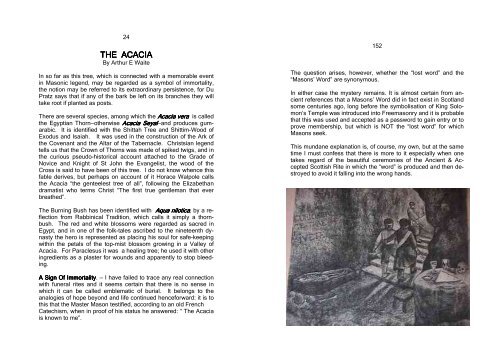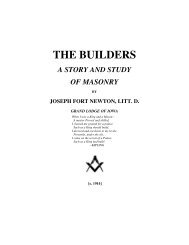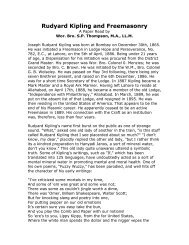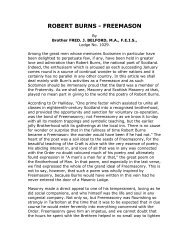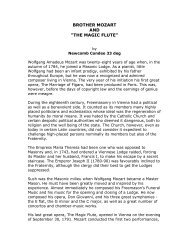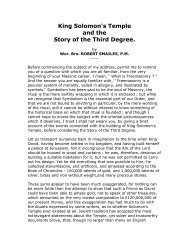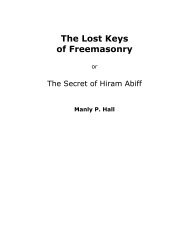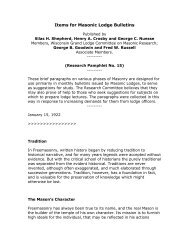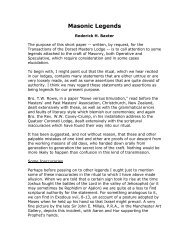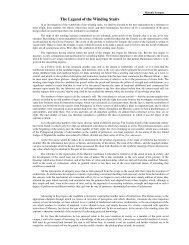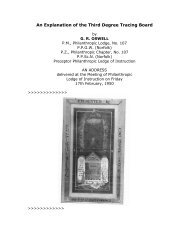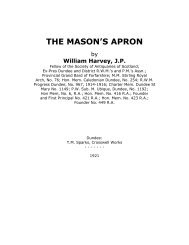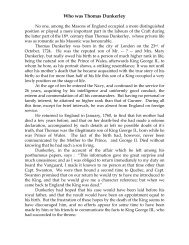Through the Key Hole - RoseCroix.org.au
Through the Key Hole - RoseCroix.org.au
Through the Key Hole - RoseCroix.org.au
Create successful ePaper yourself
Turn your PDF publications into a flip-book with our unique Google optimized e-Paper software.
24<br />
THE ACACIA<br />
By Arthur E Waite<br />
In so far as this tree, which is connected with a memorable event<br />
in Masonic legend, may be regarded as a symbol of immortality,<br />
<strong>the</strong> notion may be referred to its extraordinary persistence, for Du<br />
Pratz says that if any of <strong>the</strong> bark be left on its branches <strong>the</strong>y will<br />
take root if planted as posts.<br />
There are several species, among which <strong>the</strong> Acacia vera is called<br />
<strong>the</strong> Egyptian Thorn—o<strong>the</strong>rwise Acacia Seyal—and produces gumarabic.<br />
It is identified with <strong>the</strong> Shittah Tree and Shittim-Wood of<br />
Exodus and Isaiah. It was used in <strong>the</strong> construction of <strong>the</strong> Ark of<br />
<strong>the</strong> Covenant and <strong>the</strong> Altar of <strong>the</strong> Tabernacle. Christsian legend<br />
tells us that <strong>the</strong> Crown of Thorns was made of spiked twigs, and in<br />
<strong>the</strong> curious pseudo-historical account attached to <strong>the</strong> Grade of<br />
Novice and Knight of St John <strong>the</strong> Evangelist, <strong>the</strong> wood of <strong>the</strong><br />
Cross is said to have been of this tree. I do not know whence this<br />
fable derives, but perhaps on account of it Horace Walpole calls<br />
<strong>the</strong> Acacia “<strong>the</strong> genteelest tree of all”, following <strong>the</strong> Elizabethan<br />
dramatist who terms Christ “The first true gentleman that ever<br />
brea<strong>the</strong>d”.<br />
152<br />
The question arises, however, whe<strong>the</strong>r <strong>the</strong> “lost word” and <strong>the</strong><br />
“Masons’ Word” are synonymous.<br />
In ei<strong>the</strong>r case <strong>the</strong> mystery remains. It is almost certain from ancient<br />
references that a Masons’ Word did in fact exist in Scotland<br />
some centuries ago, long before <strong>the</strong> symbolisation of King Solomon’s<br />
Temple was introduced into Freemasonry and it is probable<br />
that this was used and accepted as a password to gain entry or to<br />
prove membership, but which is NOT <strong>the</strong> “lost word” for which<br />
Masons seek.<br />
This mundane explanation is, of course, my own, but at <strong>the</strong> same<br />
time I must confess that <strong>the</strong>re is more to it especially when one<br />
takes regard of <strong>the</strong> be<strong>au</strong>tiful ceremonies of <strong>the</strong> Ancient & Accepted<br />
Scottish Rite in which <strong>the</strong> “word” is produced and <strong>the</strong>n destroyed<br />
to avoid it falling into <strong>the</strong> wrong hands.<br />
The Burning Bush has been identified with Aqua nilotica, by a reflection<br />
from Rabbinical Tradition, which calls it simply a thornbush.<br />
The red and white blossoms were regarded as sacred in<br />
Egypt, and in one of <strong>the</strong> folk-tales ascribed to <strong>the</strong> nineteenth dynasty<br />
<strong>the</strong> hero is represented as placing his soul for safe-keeping<br />
within <strong>the</strong> petals of <strong>the</strong> top-mist blossom growing in a Valley of<br />
Acacia. For Paraclesus it was a healing tree; he used it with o<strong>the</strong>r<br />
ingredients as a plaster for wounds and apparently to stop bleeding.<br />
A Sign Of Immortality. — I have failed to trace any real connection<br />
with funeral rites and it seems certain that <strong>the</strong>re is no sense in<br />
which it can be called emblematic of burial. It belongs to <strong>the</strong><br />
analogies of hope beyond and life continued henceforward: it is to<br />
this that <strong>the</strong> Master Mason testified, according to an old French<br />
Catechism, when in proof of his status he answered: “ The Acacia<br />
is known to me”.


